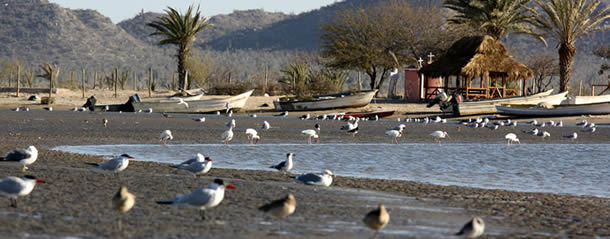By Emily Wittman
Trudging through waist high water, losing shoes in 12 inch deep mud flats, kayaking to remote sections of estuaries, and feeling the breeze whipping against your face on the boat ride to Isla Alcatraz are all in a day’s work if you are a Research and Conservation Fellow for the Waterbird Monitoring Program at the Kino Bay Center for Cultural and Ecological Studies. “The Center” is Prescott College’s field station on the shores of the Gulf of California in Sonora, Mexico. Prescott College has had a presence in this ecologically and culturally unique region since 1969, when classes first explored Sonora and the Midriff Islands. The mission of the Kino Bay Center is to protect priority species and habitats through the integrated application of science, education, information exchange, and community participation.

In addition to collecting waterbird census data, the WMP focuses on the behavior, phenology, and productivity of nesting waterbirds. Of particular interest are those identified as critical species such as Reddish Egret (Egretta rufescens). Reddish Egret is a rare species and a habitat specialist with a declining population. Isla Alcatraz, just off the coast of Kino Bay, hosts a large colony of nesting Reddish Egrets. In collaboration with Dr. Eduardo Palacios from CICESE, the WMP is participating in range-wide banding project, in which 47 chicks were tagged in June, 2012. The WMP has become an active member of the Reddish Egret Working Group, which is currently drafting a Conservation Action Plan for the species.
In the winter of 2012, The Center organized the “Legal Tools for the Conservation of Estero Santa Cruz Workshop,” which brought experts from throughout Mexico together with local community members, ecology club students, academics, scientists, and governmental officials to discuss the next steps for the conservation of the local estuary and develop an action plan. As a direct result of the workshop and data collected over the years by the WMP, The Center recently submitted an application for Estero La Cruz to become a Ramsar site. The estuary is home to at least 19 species of nesting waterbirds, of which six are listed under the Mexican Endangered Species Act (NOM-ECOL-059-2010), and nine are SJV species of concern. If selected as a Ramsar site, Estero La Cruz will finally see the recognition it deserves for its incredible biodiversity and local importance, and the Prescott College Kino Bay Center will take on the task of working with CONANP and the University of Sonora to create a management plan for the estuary.
To learn more about the WMP and the work of the Prescott College Kino Bay Center, visit their website.

